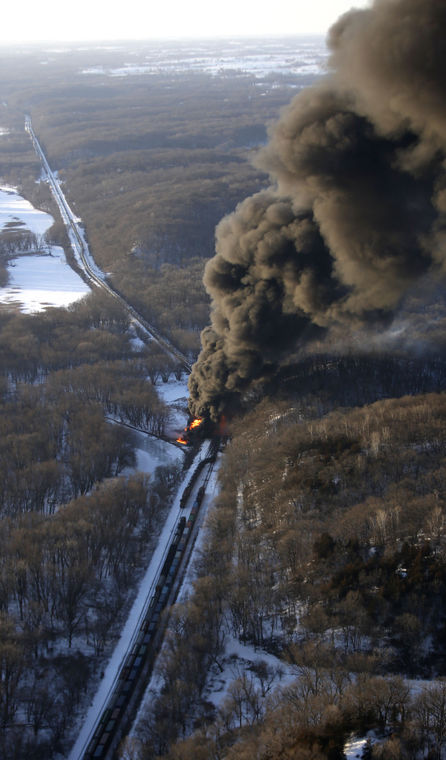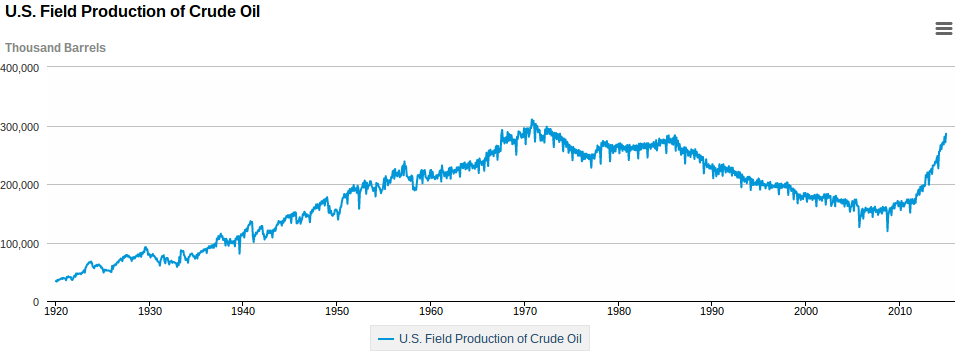 |
| Mike Burley, THONLINE |
Another week another bomb train, it seems. Last week it was West Virginia, this week Galena Illinois. This time a 105 car train, 103 of which were crude oil tankers, derailed in a remote section of Illinois just off the Mississippi River. According to a news report by a local news team![]() , eight cars of the BNSF train left the tracks at least two of which caught fire. Crews were able to get to the remote scene using a bicycle path, but had to evacuate when the fire became too intense. They’ve decided to let the fire run its course, probably due to the intensity (other oil train fires have also been allowed to burn themselves out after crews couldn’t extinguish them), but the remoteness would hamper efforts to bring fire-fighting equipment to the scene. (there’s a Reuters report that’s also worth reading
, eight cars of the BNSF train left the tracks at least two of which caught fire. Crews were able to get to the remote scene using a bicycle path, but had to evacuate when the fire became too intense. They’ve decided to let the fire run its course, probably due to the intensity (other oil train fires have also been allowed to burn themselves out after crews couldn’t extinguish them), but the remoteness would hamper efforts to bring fire-fighting equipment to the scene. (there’s a Reuters report that’s also worth reading![]() ) (pictures from another local news report show a Homeland Security Command Post on the scene
) (pictures from another local news report show a Homeland Security Command Post on the scene![]() , BTW – what woulda happened if the Republican-led attempt to defund Homeland Security had happened? Would the local response been hampered?)
, BTW – what woulda happened if the Republican-led attempt to defund Homeland Security had happened? Would the local response been hampered?)
Going by pictures posted in that news report – and cross verifying with Google Maps – the train was in the process of crossing a bridge over the Galena River, a tributary to the Mississippi. Immediately after the bridge the rail line splits into three parallel lines, and the lead cars had just started switching to one of those lines while two other trains were on the other lines. The derailed cars were just a few cars behind the engines, it seems, right at the switcher thingy. A channel of the Mississippi river runs right next to the track, and some of the above pictures show flames encroaching the Mississippi.
We don’t need to go too deep into this specific story. I expect they’ll find a flaw in the rail at the switching mechanism caused the derailment. It’s already known the DOT-111 rail cars are unsafe – this train was carrying Bakken oil, meaning it had come from North Dakota and therefore was likely to be using the DOT-111.
Instead I want to refer to my recent research project – a summary of the full lifecycle of gasoline from well to refinery to wheel to air![]() . I just happen to have finished reading a lot of reports about the oil trains. The page I just linked is raw, unedited, about 8000 words long and over 100 footnotes, and it isn’t even finished. But it’s eye-opening as to the extent of the toxicity in the gasoline lifecycle.
. I just happen to have finished reading a lot of reports about the oil trains. The page I just linked is raw, unedited, about 8000 words long and over 100 footnotes, and it isn’t even finished. But it’s eye-opening as to the extent of the toxicity in the gasoline lifecycle.
Why are the oil companies shipping crude oil by train? We’ve had over a dozen train derailments since July 2013, obviously something is wrong and the oil companies should use a different method, right?
The reason why they’re using trains is the lack of pipeline capacity from North Dakota and Alberta. Both those areas have made a massive jump in oil production since 2010. How much it’s been is jaw dropping.
This image shows oil production per month since 1920, and is sourced from the US Energy Information Administration. It shows the peak of US oil production in 1970, just as M. King Hubbert predicted. It shows that US production plateau’d until about 1985 when it started to decline. By 2005 US oil production had fallen to 140-150 million barrels per month from the peak of 308 million barrels per month in 1970. But in 2010 US oil production took off like a rocket, going from about 170 million barrels per month that year to nearly 300 million barrels per month in December 2014.
That means there’s a heck of a lot of oil coming out of North Dakota, as well as the Eagle Ford and Permian shale formations in Texas. Since this chart is US oil production it doesn’t include the Alberta Tar Sands oil, that’s also being shipped by rail.
It’s more expensive to ship oil by rail – about $15 per barrel versus $5 per barrel for shipping by pipeline. That’s a big disincentive to shipping by rail, but the amount of shipping by rail has also exploded (if you’ll pardon my use of that word) in the same time frame.
The problem is that this oil production has ballooned (I knew I could find a non-explosive word) so rapidly that the oil companies haven’t been able to install the enough infrastructure, yet.
And, by the way, the fight over the Keystone XL pipeline is extremely related to these two charts. They want that pipeline so they can more cheaply transport by pipeline this massive oil flow they’re now shipping.
Lacking pipeline capacity there are two alternatives – rail, and barge. Barges are used for shipping crude oil, and it’s only a matter of time before one runs into a bridge or something, because barges hit bridges all the time. There are even proposals afoot to use the Great Lakes to ship oil to refineries in that region. Unfortunately there are insufficient suitable cargo boats in the Great Lakes fleet.
We can breath a sigh of relief that only a couple of these rail cars caught fire, unlike some of the other oil train accidents.
However, we should be expecting about 10 of these oil train derailments a year for the next 20 years. That’s the prediction of the US Dept of Transportation last summer. It’s only March, and if I’m remembering right there’s been 4 already this year. Those were crude oil trains, a couple weeks ago there was an ethanol train derailment a few miles north of this one.
The oil trains are using regular train lines across the country, meaning they’re going through peoples back yards and through downtowns across America. What happens when one of these trains blows up in a downtown? The first of the oil train explosions, in July 2013, in Lac-Mégantic, Quebec, did hit a downtown area of a small town. It basically destroyed the town and killed over 40 people.
We collectively have an addiction to the stuff made from crude oil – gasoline, diesel, jet fuel, asphalt, etc. Groups like 350.org want us to think of the sole threat from fossil fuels is the carbon put into the atmosphere. Yes, that’s alarming, and climate change is a serious threat, but there are many many many other effects of crude oil. Go to the gasoline life-cycle page I linked above and you’ll see.
Because crude oil is being spilled at this site, that local area has now become infested with a quantity of highly toxic crude oil. It’s full of benzenes and tuolene’s and Polycyclic aromatic hydrocarbons (PAHs) all of which are highly carcinogenic.
- Highway design could decrease death and injury risk, if “we” chose smarter designs - March 28, 2015
- GM really did trademark “range anxiety”, only later to abandon that mark - March 25, 2015
- US Government releases new regulations on hydraulic fracturing, that some call “toothless” - March 20, 2015
- Tesla Motors magic pill to solve range anxiety doesn’t quite instill range confidence - March 19, 2015
- Update on Galena IL oil train – 21 cars involved, which were the supposedly safer CP1232 design - March 7, 2015
- Another oil bomb train – why are they shipping crude oil by train? – Symptoms of fossil fuel addiction - March 6, 2015
- Chevron relinquishes fracking in Romania, as part of broader pull-out from Eastern European fracking operations - February 22, 2015
- Answer anti- electric car articles with truth and pride – truth outshines all distortions - February 19, 2015
- Apple taking big risk on developing a car? Please, Apple, don’t go there! - February 16, 2015
- Toyota, Nissan, Honda working on Japanese fuel cell infrastructure for Japanese government - February 12, 2015























Pingback: Avoidable train wrecks that kill passengers or destroy towns | The Long Tail Pipe